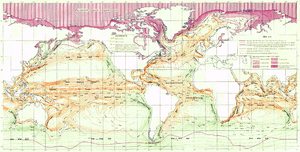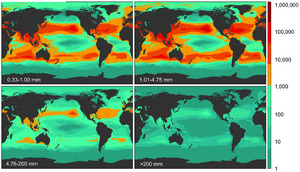South Pacific garbage patch facts for kids
The South Pacific garbage patch is a huge area in the Pacific Ocean where lots of plastic trash and tiny plastic pieces float around. It's found in a part of the ocean called the South Pacific Gyre. This gyre stretches from east of Australia all the way to South America. It goes as far north as the Equator and south to the Antarctic Circumpolar Current.
When plastics break down in the ocean, they can release harmful chemicals. Scientists confirmed this garbage patch in mid-2017. It's like the Great Pacific garbage patch was ten years ago. You can't see the South Pacific garbage patch from satellites because most of the plastic pieces are smaller than a grain of rice.
Contents
How Was the South Pacific Garbage Patch Found?
Scientists first suspected a garbage patch in the South Pacific in 2011. Its existence was officially confirmed in mid-2017. This discovery happened after a research trip by the 5 Gyres Institute.
The First Research Trip
The first trip took place from March to April 2011. Researchers followed a path based on ocean current models. These models were created by Nikolia Maximenko from the University of Hawaii. They helped predict where floating trash would gather.
The expedition started near Robinson Crusoe Island in Chile. The team then traveled west, collecting new water samples every 50 nautical miles. They reached the waters near Easter Island and later Pitcairn Island.
The Second Research Trip
A second water sampling trip began on November 2, 2016. It started from Long Beach, California and lasted six months. Charles J. Moore led this trip with a team from Algalita Marine Research and Education.
Their ship traveled south along the Baja California peninsula to the Galapagos Islands. From there, they continued southwest to Easter Island. After leaving Easter Island, the crew headed east to the Juan Fernandez Islands. Then, they went north along the coast of Chile, stopping at Antofagasta, Chile and Arica, Chile. Finally, they headed back out to sea for their return journey to Long Beach.
What Is the South Pacific Garbage Patch Made Of?
During the 5 Gyres expedition, scientists took 48 samples. They found a lot more plastic pollution than expected. On average, there were about 26,898 plastic pieces per square kilometer. In some spots, this number jumped to 396,342 pieces per square kilometer. Near the center of the predicted trash zone, some estimates were as high as one million particles per square kilometer!
What Kind of Plastic Is It?
The garbage patch is mostly made of tiny plastic pieces. These include:
- Microbeads: These are very small, less than 5 micrometers in size. They used to be in some personal care products.
- Microscopic fibers: These come from washing clothes.
- Fishing debris: This includes lost or discarded fishing gear from southern hemisphere fishermen.
- Tiny fragments: These are microscopic pieces from larger plastics that have broken down in the ocean.
How Big Is the Garbage Patch?
The high levels of pollution cover a huge area. It's estimated to be about 2.6 million square kilometers (one million square miles). That's about 1.5 times the size of Texas! The trash was found along a straight line route nearly 2,500 nautical miles long.
How Does the Garbage Patch Affect Ocean Life?
The plastic in the ocean can cause many problems for marine animals. Fish, birds, and other sea creatures can mistake plastic pieces for food. When they eat plastic, it can block their stomachs and make them feel full, even though they aren't getting any nutrients. This can lead to starvation.
Dangers to Animals
Animals can also get tangled in larger pieces of plastic, like fishing nets or plastic bags. This can prevent them from swimming, hunting, or even breathing properly. It can also cause injuries or make them unable to escape from predators.
Harmful Chemicals
As plastics break down into smaller pieces, they can release harmful chemicals into the water. These chemicals can then be absorbed by marine life. When smaller fish eat these chemicals, they can build up in their bodies. Then, when bigger fish eat the smaller fish, the chemicals move up the food chain. This can eventually affect humans who eat seafood.
Impact on the Ocean Environment
The garbage patch also changes the ocean environment itself. It can block sunlight from reaching plants and algae below the surface. These plants are important for producing oxygen and providing food for other creatures. The plastic can also carry invasive species to new areas, which can harm local ecosystems.
See also
- South Pacific Gyre
- South Atlantic Gyre
- Marine debris
- Plastic pollution



